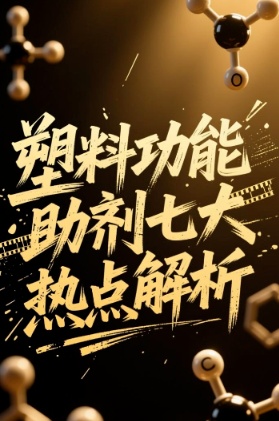Understanding 7 key hotspots of plastic functional additives: Flame Retardant, Weather Resistant, Conductive, Reinforcing, Abrasion Resistant, Antibacterial, Hydrolysis Resistant
The seven major hotspots of plastic additives precisely summarize the most core and active research and application directions in the current field of plastic functional additives. These additives endow the basic resins with properties they originally did not possess, significantly expanding the application boundaries of plastics. They are a key component in high-end manufacturing and industrial upgrading.

Below, I will provide a detailed analysis of the functions, principles, commonly used materials, and application areas of these seven major hot additives.
Flame retardant
Function: Translate the above content into English and output the translation directly without any explanation.Enhance the fire safety of plastics, delay the spread of flames, suppress smoke production, and gain valuable time for personnel evacuation and firefighting efforts.
Principle of Operation:The main methods include absorbing heat to cool down (such as aluminum hydroxide, magnesium hydroxide), covering to isolate oxygen (such as intumescent flame retardants), and capturing free radicals to interrupt the combustion reaction (such as halogenated and phosphorus flame retardants).
Common materials:
🔺Halogen-free flame retardant (mainstream trend):Phosphorus-based (DOPO, TPP), nitrogen-based (MCA), inorganic hydroxides (ATH, MDH), intumescent flame retardants (IFR).
🔺Halogenated flame retardants (gradually restricted):Brominated and chlorinated compounds (due to environmental and health concerns, their use is gradually decreasing).
Application Areas:Household appliance casings (such as chargers and televisions), electronic products (circuit boards, connectors), new energy vehicle battery packs, construction materials (insulated cables, thermal insulation materials), transportation (aircraft and high-speed rail interior parts).
2. Weathering Agent
Function: Translate the above content into English and output the translation directly without any explanation.To delay the aging and degradation of plastics caused by environmental factors such as light exposure (especially ultraviolet light), oxygen, heat, and humidity, and to prevent discoloration, brittleness, surface chalking, loss of gloss, and loss of mechanical properties.
Principle of operation:
🔺Ultraviolet Absorber (UVA):Compounds such as benzophenones and benzotriazoles absorb and convert ultraviolet light energy into harmless thermal energy, similar to how "sunscreen" works.
🔺Hindered amine light stabilizers (HALS):Capture free radicals generated during the degradation process, interrupt the chain reaction, and achieve high efficiency and long-lasting effect.
🔺Antioxidant (AO):Inhibit thermal-oxidative aging.
Application field:Outdoor building materials (door and window profiles, roofing tiles, railings), automotive parts (bumpers, rearview mirrors, car lights), outdoor sports facilities, gardening supplies, photovoltaic backplanes.
3. Conductive agent
Principle of operation:Form a conductive network by adding conductive substances.
🔺Carbon-based materials:Carbon black (most commonly used, low cost), carbon nanotubes (CNTs, efficient, low additive amount), graphene (extreme performance, high cost).
🔺Metal materials:Metal fibers (stainless steel), metal powders (silver, copper, nickel, high cost and easy to oxidize), metal-coated fibers/glass beads.
🔺Intrinsic Conducting Polymer (ICP)PEDOT:PSS, etc., used for highly transparent anti-static coatings.
Application areas:Antistatic packaging (electronic components, mining pipelines), EMI shielding covers (mobile phone/computer cases, automotive radar modules), self-heating materials (car seat heating, de-icing pipelines), sensor electrodes.
4. Enhancer
Principle of operation:Carrying and transmitting stress through high-intensity fillers.
🔺Fibers:Fiberglass (most common), carbon fiber (high-end, high-strength lightweight), aramid fiber.
🔺Whiskers/Minerals:Calcium carbonate (CaCO₃, low-cost weight and stiffness enhancer), talc powder (improves stiffness and surface hardness), wollastonite.
Application areas:Automobile parts (engine hoods, fan blades), electronic and electrical enclosures (structural parts with high rigidity requirements), tool housings (electric drills, angle grinders), sports equipment (bicycle frames, skis).
5. Abrasive agent
Operating principle:By forming a lubricating layer on the surface or increasing surface hardness.
🔺SiliconeSilicone masterbatch migrates to the surface to form a lubricating layer.
🔺Waxes:Polyethylene wax (PE Wax), polytetrafluoroethylene micropowder (PTFE, with an extremely low coefficient of friction).
🔺Rigid packing:Silicon dioxide (SiO₂), silicon carbide (SiC), etc., enhance surface hardness.
🔺MoS₂ (Molybdenum disulfide), graphite:Solid lubricant.
Application domain:Gears, bearings, sliders and other moving parts, automotive interiors (dashboards, buttons), flooring (PVC floor leather), guide wheels, guide rails.
6. Antimicrobial agent
Principle of operation:By disrupting the cell structure of microorganisms or interfering with their metabolism through contact.
🔺 Inorganic antibacterial agent:Silver ions, zinc ions, copper ions and their compounds (such as silver-loaded zeolite, nano zinc oxide), long-lasting and heat resistant.
🔺Organic Antibacterial Agent:Isothiazolinones, quaternary ammonium compounds, etc., act quickly but may have issues with heat resistance and long-lasting efficacy.
Application field:Household appliances (refrigerator liners, washing machine sealing rings, air conditioner filters), medical devices, food packaging, children's toys, bathroom facilities, electronic product casings.
7. Hydrolysis inhibitor
Principle of operation:
🔺Scavenger:Carbodiimides (especially polycarbodiimides) are mainstream, as they preferentially react with water and effectively neutralize acidic by-products (carboxylic acids) generated from hydrolysis, preventing autocatalytic reactions.
End-capping agent:The active end groups of polymer chains (such as -OH, -COOH) block the initiation sites of hydrolytic attack.
Application field: Crucial!Engineering plastic parts used in high-temperature and high-humidity environments, such as connectors for new energy vehicle battery packs (PA), outdoor electronic junction boxes (PBT), yarn fibers in hot and humid environments (PET), and shoe soles and midsoles (PU).
Summary and Trends
The seven major trends fully reflect the development direction of the plastics industry.High performance, functionalization, safety, and greeningThe future trend is:
1. Environmental Protection and Safety:Halogen-free flame retardants and heavy metal-free antibacterial agents are the absolute mainstream in environmentally friendly additives.
2. Efficiency and versatility:Develop efficient additives with low dosage (such as carbon nanotubes), and an additive that possesses multiple functions (such as both weather resistance and hydrolysis resistance).
3. Nanotechnology Applications:Nanomaterials (such as nano SiO₂ and graphene) exhibit great potential in enhancement, wear resistance, and conductivity fields.
4. Responding to new demands:With the boom of emerging industries such as 5G, new energy vehicles, and wearable devices, higher requirements have been placed on the electromagnetic shielding, thermal conductivity, and hydrolysis resistance of plastics, driving continuous innovation in additive technology.
The seven major hot additives are the "behind-the-scenes contributors" that have transformed modern plastics from a general-purpose material into the core components of various high-tech products.
【Copyright and Disclaimer】The above information is collected and organized by PlastMatch. The copyright belongs to the original author. This article is reprinted for the purpose of providing more information, and it does not imply that PlastMatch endorses the views expressed in the article or guarantees its accuracy. If there are any errors in the source attribution or if your legitimate rights have been infringed, please contact us, and we will promptly correct or remove the content. If other media, websites, or individuals use the aforementioned content, they must clearly indicate the original source and origin of the work and assume legal responsibility on their own.
Most Popular
-

List Released! Mexico Announces 50% Tariff On 1,371 China Product Categories
-

EU Changes ELV Regulation Again: Recycled Plastic Content Dispute and Exclusion of Bio-Based Plastics
-

Case Study | Clariant AddWorks™ Additives Solve Plastic Yellowing Problem
-

Mexico officially imposes tariffs on 1,400 chinese products, with rates up to 50%
-

Wanhua Chemical Transforms Annual Production of 60,000 Tons PBAT Facility to Produce PETG






